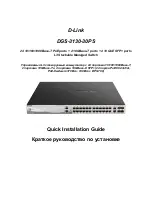
Configure a Port for a Bridge-to-Bridge Link
If a switch port is connected to another FIP snooping bridge, configure the FCoE-Trusted Port mode for
bridge-bridge links.
Initially, all FCoE traffic is blocked. Only FIP frames with the ALL_FCF_MAC and ALL_ENODE_MAC values
in their headers are allowed to pass. After the switch learns the MAC address of a connected FCF, it
allows FIP frames destined to or received from the FCF MAC address.
FCoE traffic is allowed on the port only after the switch learns the FC-MAP value associated with the
specified FCF MAC address and verifies that it matches the configured FC-MAP value for the FCoE VLAN.
Configure a Port for a Bridge-to-FCF Link
If a port is directly connected to an FCF, configure the port mode as FCF. Initially, all FCoE traffic is
blocked; only FIP frames are allowed to pass.
FCoE traffic is allowed on the port only after a successful fabric login (FLOGI) request/response and
confirmed use of the configured FC-MAP value for the VLAN.
FLOGI and fabric discovery (FDISC) request/response packets are trapped to the CPU. They are forwarded
after the necessary ACLs are installed.
Impact on Other Software Features
When you enable FIP snooping on a switch, other software features are impacted. The following table
lists the impact of FIP snooping.
Table 23. Impact of Enabling FIP Snooping
Impact
Description
MAC address learning
MAC address learning is not performed on FIP and
FCoE frames, which are denied by ACLs
dynamically created by FIP snooping on server-
facing ports in ENode mode.
MTU auto-configuration
MTU size is set to mini-jumbo (2500 bytes) when a
port is in Switchport mode, the FIP snooping
feature is enabled on the switch, and FIP snooping
is enabled on all or individual VLANs.
Link aggregation group (LAG)
FIP snooping is supported on port channels on
ports on which PFC mode is on (PFC is
operationally up).
STP
If you enable an STP protocol (STP, RSTP, PVSTP,
or MSTP) on the switch and ports enter a blocking
state, when the state change occurs, the
corresponding port-based ACLs are deleted. If a
port is enabled for FIP snooping in ENode or FCF
mode, the ENode/FCF MAC-based ACLs are
deleted.
FCoE Transit
367
Summary of Contents for S4820T
Page 1: ...Dell Configuration Guide for the S4820T System 9 8 0 0 ...
Page 282: ...Dell 282 Control Plane Policing CoPP ...
Page 622: ...Figure 81 Configuring Interfaces for MSDP 622 Multicast Source Discovery Protocol MSDP ...
Page 623: ...Figure 82 Configuring OSPF and BGP for MSDP Multicast Source Discovery Protocol MSDP 623 ...
Page 629: ...Figure 86 MSDP Default Peer Scenario 2 Multicast Source Discovery Protocol MSDP 629 ...
Page 630: ...Figure 87 MSDP Default Peer Scenario 3 630 Multicast Source Discovery Protocol MSDP ...
Page 751: ...10 11 5 2 00 00 05 00 02 04 Member Ports Te 1 2 1 PIM Source Specific Mode PIM SSM 751 ...
Page 905: ...Figure 112 Single and Double Tag First byte TPID Match Service Provider Bridging 905 ...
Page 979: ...6 Member not present 7 Member not present Stacking 979 ...
Page 981: ...storm control Storm Control 981 ...
Page 1103: ...Figure 134 Setup OSPF and Static Routes Virtual Routing and Forwarding VRF 1103 ...
















































